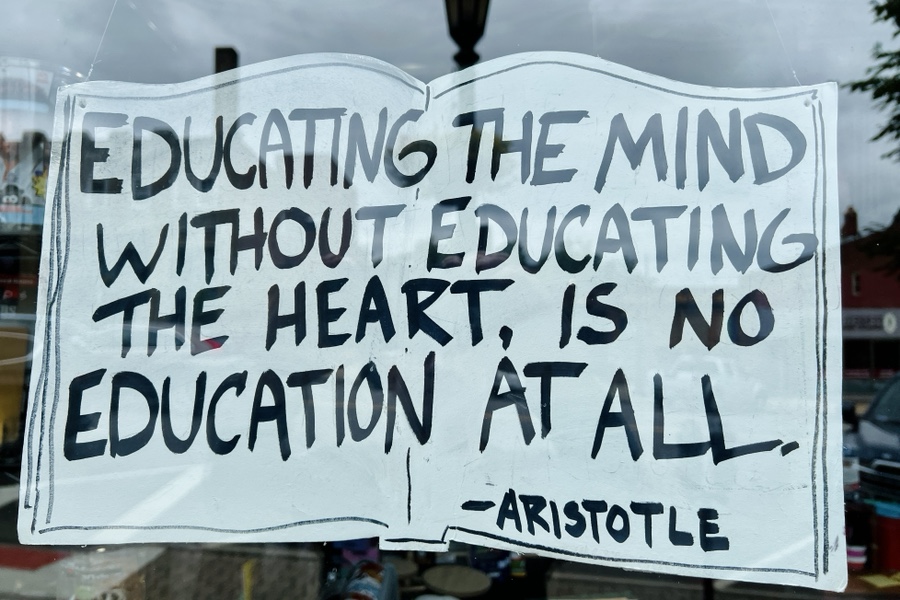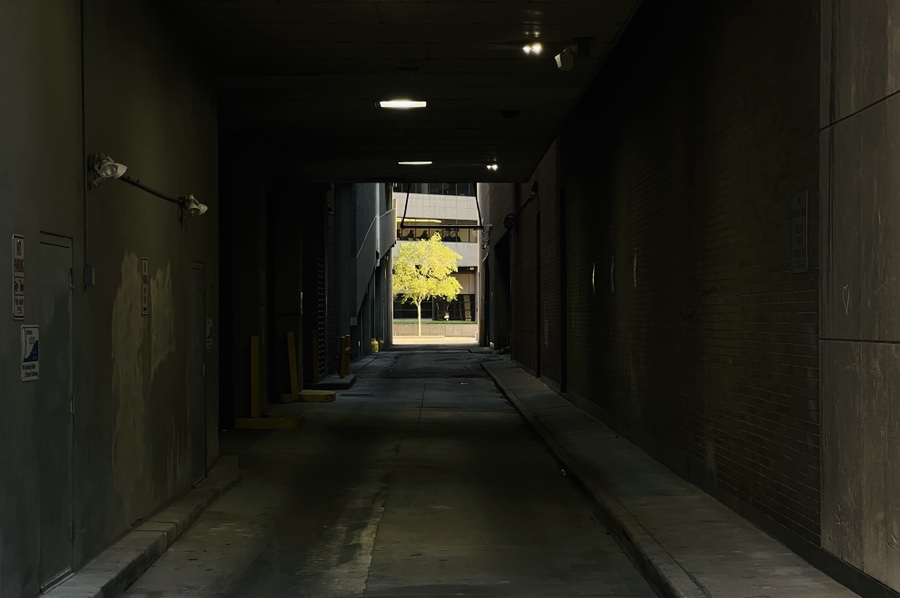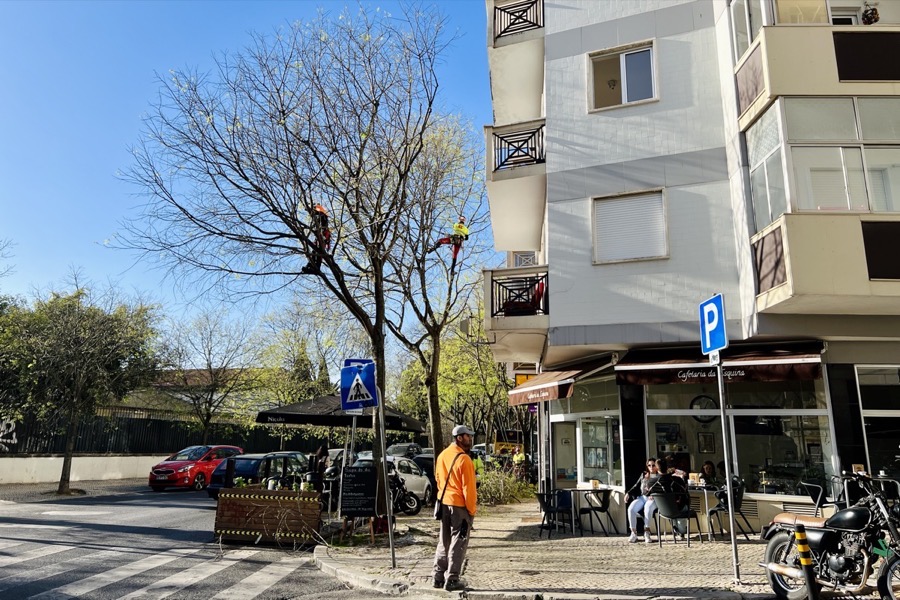02024-04-06 | Musings, Technology
Music of Sound showed a play for our time in three acts on this post.
Act one, in which a tech bro wants to convince the musician to release on Spotify:

Act two, in which the musician is reluctant and the tech bro makes grand claims to win him over:

Act three, in which the tech bro finds out that musicians aren’t stupid and is schooled.

THE END
6k ≠ 200k.
Musicians can’t just grow an audience.
Streaming as a business model doesn’t benefit musicians and may not be around for very long because even the streaming companies are not making any money – except the CEOs, of course.
I am actually contemplating releasing a music cassette next… :-)
02023-09-04 | Photos, Studio, Technology, Touring
It was great playing duets with Jon last week. Three cities, six shows. Can’t get much simpler than a guitar and an upright bass. We can do a lot with that… Well, we had a good time.
I saw this in the window of a bookstore in Kent: I returned yesterday evening and today I threw myself into binaural surround sound mixing, using SPAT Revolution. I watched a video and then pulled up a piece from Rain Poems to experiment. It was very frustrating at first. All I got was distorted sound. I’m still not sure what I did wrong. I messed with some faders and clicked some software buttons and suddenly it was working. It’s a whole different game, isn’t it!? I think this surround sound mixing will require making drawings and diagrams and using automation and and and.
I returned yesterday evening and today I threw myself into binaural surround sound mixing, using SPAT Revolution. I watched a video and then pulled up a piece from Rain Poems to experiment. It was very frustrating at first. All I got was distorted sound. I’m still not sure what I did wrong. I messed with some faders and clicked some software buttons and suddenly it was working. It’s a whole different game, isn’t it!? I think this surround sound mixing will require making drawings and diagrams and using automation and and and.
The excitement over Dolby Atmos at Apple Music always seemed over the top to me. I find it’s a lot like pushing Blu-ray over DVD. The story of a film captivates me more than sheer technological brilliance and pixel count. In addition, DVD was old technology and therefore accessible to more movie productions worldwide and I don’t often watch Hollywood films anyway. So I never bothered buying a Blu-ray player. Similarly, melodies and the musical performance are more important to me than hearing something in spectacular quality. It’s a trade off, isn’t it. I mean if you can dedicate a room to listening, and outfit it with 50-100k of great equipment and loudspeakers, I am sure it would be glorious. I might come for a visit but it’s not really for me. (wouldn’t it be cool if one could rent a room with an amazing sound system by the hour?)
My first impression is that the SPAT Revolution software is really impressive and that I should keep working with it, to see where it can take the music, but stereo is pretty damn good and compatible with more ways to listen. What’s your favorite way to listen to music? Loudspeakers? A surround sound speaker array? Headphones? The car? A mono bluetooth speaker?
I’ll end this post with a photo from Indianapolis: 
02023-08-20 | Computer, Recording, Studio, Technology
This month AVID, makers of the most ubiquitous studio recording software, Pro Tools, was sold to a Private Equity firm. I found this article about Private Equity very illuminating.
What can we expect? I think support will be slashed, subscription rates will be hiked, development will be cut…
What can you do?
Plan A:
We don’t update a hammer, or a guitar annually, but we have become used to (we were trained to?) updating our hardware and software regularly. While I have generally done that with my phone, I never did that with my recording computer and software. Everything until 2021, and including Bare Wood 2, was recorded on a Macintosh computer dating from 2003. The computer was running Pro Tools version 6.9.1, which was released in the fall of 2005. Very stable. So, I suggest using the perpetual version of the Pro Tools software and freezing your system. I use the perpetual version of PT (software version 23.6.0.110), running on my two year old MacBook Pro with the M1 Pro chip. That version of PT is finally running on Apple Silicon without Rosetta. All of my plugins are running natively as well. Mac OS 13.5.1 seems very stable. So this is where the laptop and the software will remain. Get out of the crazy updating cycle. A digital audio workstation is a tool, not something that needs to be changed constantly.
Plan B:
I also hear good things about Studio One.
02023-08-19 | Technology
A CD sold for about $17 in the early to mid Eighties. That’s about $53 in today’s money.
And yet, CDs still sell for around $17 today. They are cheap! While everything else went up in price CDs did not. Today they are sold for roughly one third of the value they sold for forty years ago.
I know, production costs have come down. CDs are mature, old technology. The truth is, even at this low, low price most musicians would be happy to sell as many CDs as they used to but as a culture we have pivoted to streaming. I could argue that’s because some people in Silicon Valley saw a way to make a lot of money by disrupting the industry and because the established record business was to slow in recognizing that. But the horses have left the barn.
When all, or most of the world’s music is available for around $10/month why wouldn’t we take advantage of that! I also buy less CDs than I used to. I remember walking into Tower Records, in the early 90s and buying ten or twenty CDs at a time… I do buy digital music albums in support of some artists but I am wary of accumulating more stuff since I moved a couple of years ago and I am sure I’ll move again.
I am reminded of Bruce Sterling, who said that no matter what happens, it happened to musicians first. He said this during a talk in 2014, just about a decade ago.
In his performative talk, Bruce Sterling uses the music industry as a lens to take a closer look at the creative industries. According to Sterling, no matter what happens, it happened to musicians first.
For instance, musicians were the first to adapt to digital realities. Sterling refers to the development of music media, from vinyl to the cd, then over to the mp3, onwards to streaming and then back to vinyl again. Despite the music industry’s ability to adapt to the digital age there is still no sustainable revenue model for musicians.
Whatever Happens to Musicians Happens to Everybody by Bruce Sterling
The way forward, at least for me, is pivoting music from mass-manufactured goods towards crafted objects. For example, selling a CD that I will burn, that I will sign, and that can be created with a unique sequence of tracks requested by the person buying the CD. Others will undoubtably arrive at different solutions. All of this will appear completely different, and even obvious, in the review mirror. To be revisited in ten years, although it will most likely take much longer to create a new thriving musician culture. Old people, like myself, may miss the 70s, 80s and the first half of the 90s. :-)
02023-07-30 | Music, Technology
Spotify created this mess. And the other music platforms are no better.
Boredom is built into the platform, because they lose money if you get too excited about music—you’re like the person at the all-you-can-eat buffet who goes back for a third helping. They make the most money from indifferent, lukewarm fans, and they created their interface with them in mind. In other words, Spotify’s highest aspiration is to be the Applebee’s of music.
Panic Among the Streamers – by Ted Gioia
Because, when you get excited about an album you might want to, well, get into it, you know, maybe by owning the files or a CD and by having a decent PDF or paper cover that you can look at, and which contains information about the musicians and the instruments they performed with, the studio, the producer, the engineer, the method of recording. Not to mention photos of the instruments, the players, the microphones that were used…
But getting into that one album means that you might not want to listen to that playlist of artist X, which the streaming company created, and which is usually sprinkled with “sounds like X” artists who signed away any payment, or a significant portion of their payment, because they were promised that they would appear on the playlist with X…
For discovery, streaming is a great option, but for getting into an album or an artist it really is not. I find myself searching the internet for credits and anything else I can find out about any album I like.
I have to suppose it’s only going to get more so… because, until a law suit proves otherwise, AI will be able to compose in the style of artist X and won’t require ANY royalties.
For light listening streaming is perfect. I have long playlists of guitar music or ambient music that I listen to during flights.
Playlists created by the streaming companies are similar to the algorithm-produced feeds for social media. It may be fine for occasional discovery but you can’t see under the hood, you can’t tweak it and it often feels like someone paid to be included.
02023-04-15 | Technology, Trees
“If you write out the basic facts of trees, but framed as technology, it sounds like impossible sci-fi nonsense. Self-replicating, solar-powered machines that synthesize carbon dioxide and rainwater into oxygen and sturdy building materials on a planetary scale.”
— Jarod Anderson / www.cryptonaturalist.com
entangled systems
More trees. Everywhere. All the time. Humans were invented and enabled by trees for their entertainment, and for tree trimming, and to pick the fruit.😉 Were the trees wrong to create oxygen for the puny humans? Time will tell.
A city that takes care of its trees is a good city. In the Spring street trees receive a trim. Streets are narrow and there is no room for a big cherry picker truck to park, so men climb into the trees and cut branches. (also no big sign or someone warning people… you are expected to see what’s going on and avoid the falling branches… 🙂)

This is a huge Juniper, the biggest I have ever seen. The trunk measures between 4 and 5 feet in diameter. A steel frame supports the old branches and creates a beautiful space for sitting in the shade.





 I returned yesterday evening and today I threw myself into binaural surround sound mixing, using SPAT Revolution. I watched a video and then pulled up a piece from Rain Poems to experiment. It was very frustrating at first. All I got was distorted sound. I’m still not sure what I did wrong. I messed with some faders and clicked some software buttons and suddenly it was working. It’s a whole different game, isn’t it!? I think this surround sound mixing will require making drawings and diagrams and using automation and and and.
I returned yesterday evening and today I threw myself into binaural surround sound mixing, using SPAT Revolution. I watched a video and then pulled up a piece from Rain Poems to experiment. It was very frustrating at first. All I got was distorted sound. I’m still not sure what I did wrong. I messed with some faders and clicked some software buttons and suddenly it was working. It’s a whole different game, isn’t it!? I think this surround sound mixing will require making drawings and diagrams and using automation and and and.



